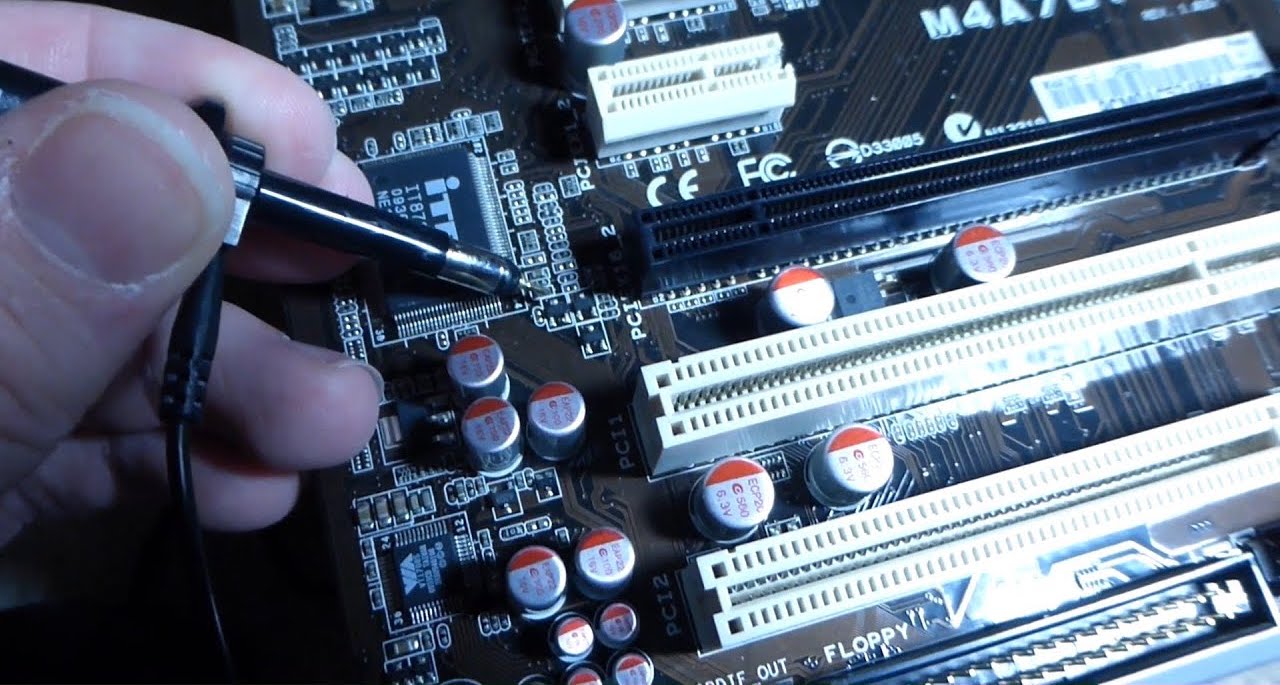Home>Home Security and Surveillance>What Type Of Intrusion Detection May Terminate Processes Or Redirect Traffic Upon Detection


Home Security and Surveillance
What Type Of Intrusion Detection May Terminate Processes Or Redirect Traffic Upon Detection
Modified: October 18, 2024
Discover the types of intrusion detection that can terminate processes or redirect traffic upon detection. Enhance your home security and surveillance with advanced solutions.
(Many of the links in this article redirect to a specific reviewed product. Your purchase of these products through affiliate links helps to generate commission for Storables.com, at no extra cost. Learn more)
Introduction
When it comes to protecting our homes and ensuring the safety of our loved ones, investing in a reliable home security and surveillance system is of utmost importance. Traditional security measures such as locks and alarms are no longer sufficient in today’s ever-evolving world, where intruders are becoming more sophisticated in their attempts to breach our defenses. This is where intrusion detection systems (IDS) play a pivotal role.
Intrusion detection systems are designed to monitor and analyze network traffic or system activity, identifying any unauthorized or malicious activities that may be taking place. These systems act as a mechanism to detect potential threats to our home security, allowing us to take necessary actions to mitigate any potential risks.
One of the key capabilities of an IDS is the ability to terminate processes upon detection. This means that when an IDS identifies a suspicious or malicious process running on our home network, it can take immediate action to shut down or terminate that process. By doing so, the IDS effectively neutralizes the potential threat and prevents any further damage or unauthorized access.
Another capability of IDS is the ability to redirect traffic upon detection. This means that when an IDS detects a network packet or data flow that raises concerns, it can redirect that traffic to a secure location for further analysis. This allows security professionals or homeowners to closely examine the traffic and better understand the nature of the potential threat, enabling them to take appropriate action to prevent any compromise or breach of the home security.
While the idea of terminating processes or redirecting traffic may seem drastic, it is a necessary step in maintaining the integrity and security of our home environments. However, it is important to understand the benefits and drawbacks of these actions, as well as to consider the specific IDS systems that offer these capabilities.
Key Takeaways:
- Intrusion detection systems (IDS) can terminate suspicious processes and redirect network traffic to protect our homes from cyber threats, but they may also cause disruptions if not carefully managed.
- Choosing the right IDS, like Snort or Suricata, is crucial for maintaining a robust home security system. These systems can proactively defend against potential threats and keep our loved ones and valuables safe.
Intrusion Detection Systems (IDS)
Intrusion Detection Systems (IDS) are the backbone of any comprehensive home security and surveillance system. They act as a vigilant watchdog, constantly monitoring network traffic, system logs, and behavior patterns to detect any unauthorized or suspicious activities that may pose a threat to our home security.
There are two main types of IDS: network-based and host-based. Network-based IDS focus on monitoring network traffic, analyzing data packets, and identifying any anomalies or potential intrusions. They typically sit at strategic points within the network, such as routers or switches, allowing them to capture and analyze traffic in real-time.
Host-based IDS, on the other hand, focus on monitoring individual host systems within the network. They analyze system logs, monitor file integrity, and look for any unusual behavior or activities at the host level. This provides a more granular view of the security posture of each individual device within the home network.
Regardless of the type, IDS utilize a range of detection techniques to identify potential threats. These techniques include signature-based detection, where known attack patterns or malicious code signatures are matched against the incoming network traffic or system activity. Another technique is anomaly-based detection, which involves establishing a baseline of normal behavior and identifying any deviations from that baseline.
IDS can be further enhanced through the use of machine learning algorithms and artificial intelligence. These advanced technologies enable IDS to continuously learn and adapt to new threats, making them more effective at detecting and mitigating emerging security risks.
One of the key capabilities of IDS is the ability to terminate processes upon detection. This means that when an IDS identifies a process that is exhibiting malicious behavior or is determined to be unauthorized, it can take immediate action to terminate that process. This proactive approach prevents any further damage or unauthorized access to our home network, ensuring the safety of our data and devices.
Another important capability of IDS is the ability to redirect traffic upon detection. When an IDS identifies suspicious or potentially malicious network traffic, it can redirect that traffic to a secure location for further analysis. This allows security professionals or homeowners to investigate the nature of the threat more closely and take appropriate action to prevent any compromise of the home network.
Implementing an IDS is a crucial step in safeguarding our home security. However, it is important to choose an IDS that suits the specific needs and requirements of our home environment. In the next sections, we will explore the benefits and drawbacks of terminating processes and redirecting traffic, as well as some examples of IDS that offer these capabilities.
Terminating Processes upon Detection
One of the key capabilities of intrusion detection systems (IDS) is the ability to terminate processes upon detection of suspicious or malicious activity. This feature allows IDS to take immediate action to neutralize potential threats, ensuring the security of our home network and devices.
When IDS identifies a process that is exhibiting malicious behavior or is determined to be unauthorized, it can terminate that process to prevent any further damage or unauthorized access. By stopping the process in its tracks, IDS effectively eliminates the potential threat and protects our home environment.
The benefits of terminating processes are numerous. Firstly, it prevents the process from causing any harm or spreading further within the system. By taking quick action to terminate a malicious process, IDS minimizes the risk of data breaches, unauthorized access, or system damage.
Terminating processes also gives us peace of mind knowing that any potential threat has been effectively dealt with. We can rest assured that our home network is secure and that we have taken proactive steps to mitigate any risks.
However, it is essential to consider the drawbacks of terminating processes as well. In some cases, terminating a process may lead to unintended consequences. For example, terminating a legitimate process by mistake can disrupt the normal functioning of applications or services, leading to system instability or downtime.
Another potential drawback is the possibility of false positives, where IDS incorrectly identifies a legitimate process as malicious and terminates it. This can potentially impact the performance or functionality of certain applications, causing inconvenience for users.
To mitigate the drawbacks and ensure effective process termination, it is crucial to choose an IDS that employs robust detection mechanisms and regularly updates its threat intelligence. IDS solutions that leverage machine learning algorithms and artificial intelligence can improve accuracy and reduce false positives, enhancing the reliability of process termination.
Overall, terminating processes upon detection is an essential feature of IDS that strengthens our home security. By promptly neutralizing potential threats, we can protect our data, devices, and privacy. It is crucial to choose a reliable IDS solution that strikes a balance between effectively terminating malicious processes and minimizing the risk of disrupting legitimate operations.
Redirecting Traffic upon Detection
Another important capability of intrusion detection systems (IDS) is the ability to redirect traffic upon detection of suspicious or potentially malicious activity. This feature allows IDS to divert the traffic to a secure location for further analysis, enabling us to better understand the nature of the threat and take appropriate action to protect our home network.
When IDS identifies network packets or data flows that raise concerns, it can redirect that traffic to a designated location for closer examination. This redirection allows security professionals or homeowners to investigate the suspicious activity and determine if it poses a threat to our home security.
Redirecting traffic has several benefits. Firstly, it provides a controlled environment for analyzing potentially malicious traffic. By redirecting the traffic to a secure location, we can examine it in isolation and minimize the risk of compromising other devices or systems within our home network.
Furthermore, redirecting traffic allows us to gather valuable information about the threat. By closely analyzing the traffic, we can identify the source of the attack, the methods being used, and any potential vulnerabilities in our network. This information is crucial for developing effective countermeasures and preventing future attacks.
In some cases, redirecting traffic can also help in identifying false positives. By thoroughly analyzing the traffic in a secure environment, we can determine if the suspicious activity was a result of a misconfiguration, a false alarm, or a legitimate yet unusual network behavior. This helps in refining the IDS rules and improving its accuracy.
However, there are a few considerations to keep in mind when redirecting traffic. Redirecting traffic adds an additional layer of complexity and potentially introduces latency to the network. Therefore, it is important to ensure that the IDS solution is properly configured and can handle the increased traffic load without causing performance issues.
Additionally, redirecting traffic requires careful monitoring and analysis. It is crucial to have skilled security professionals who can examine the redirected traffic and quickly identify any potential threats. Regular updates of threat intelligence and continuous monitoring of the redirected traffic are essential to ensure the effectiveness of the IDS.
Overall, redirecting traffic upon detection is a valuable capability of IDS that allows us to gain insights into potential threats and take appropriate actions. By analyzing the redirected traffic in a secure environment, we can enhance our understanding of the threat landscape and strengthen our home security measures.
Benefits and Drawbacks of Terminating Processes and Redirecting Traffic
Terminating processes and redirecting traffic are important capabilities of intrusion detection systems (IDS) that contribute to the overall security of our home network. However, like any security measure, there are both benefits and drawbacks to consider when implementing these actions.
Benefits:
1. Immediate threat mitigation: Terminating a suspicious or malicious process upon detection prevents further damage or unauthorized access to our home network. Redirecting traffic allows for in-depth analysis and understanding of potential threats, enabling us to take immediate and appropriate action.
2. Enhanced response time: By promptly terminating processes or redirecting traffic, IDS reduces the time it takes to respond to potential threats. This proactive approach helps to minimize the impact of attacks and prevents attackers from exploiting vulnerabilities for an extended period.
3. Protection against evolving threats: Termination and redirection help protect against emerging threats that traditional security measures may not be equipped to handle. IDS can actively detect new attack patterns and behaviors, ensuring that we stay one step ahead of potential intruders.
4. Insight into network behavior: Redirecting traffic allows us to closely examine the nature and source of suspicious activities. This provides valuable insights into the network’s vulnerabilities, allowing us to strengthen our security measures and implement targeted countermeasures.
Drawbacks:
1. False positives: IDS may mistakenly identify legitimate processes or traffic as malicious, leading to false positives. This can result in the interruption of normal operations or the inconvenience of legitimate users. Regular updates, fine-tuning of detection rules, and accurate threat intelligence are essential to minimize false positives.
2. False negatives: While terminating processes and redirecting traffic can be effective in preventing known threats, they may overlook sophisticated or zero-day attacks. IDS must constantly evolve and update to detect and mitigate emerging threats that might bypass the traditional detection mechanisms.
3. System instability: Improper termination of processes may lead to system instability or application crashes if legitimate processes are mistakenly terminated. Careful configuration and testing are necessary to avoid disrupting critical operations or causing unintended consequences.
4. Performance impact: Redirecting traffic adds an additional layer of complexity to the network and may introduce latency. It is important to choose an IDS solution that can efficiently handle the increased traffic load without adversely affecting the performance of the network.
5. Expertise and resources: Proper implementation and maintenance of IDS capabilities, such as terminating processes and redirecting traffic, require skilled security professionals and dedicated resources. Regular monitoring, analysis, and fine-tuning of the IDS are necessary to ensure its effectiveness in protecting our home network.
Overall, the benefits of terminating processes and redirecting traffic include immediate threat mitigation, enhanced response time, protection against evolving threats, and insights into network behavior. However, the drawbacks, such as false positives, false negatives, system instability, performance impact, and resource requirements, should be carefully considered to strike a balance between security and usability.
Examples of IDS that Terminate Processes or Redirect Traffic
There are several intrusion detection systems (IDS) available in the market that offer the capability to terminate processes upon detection or redirect traffic for further analysis. Let’s explore some examples of IDS that provide these functionalities:
1. Snort
Snort is an open-source network IDS that is widely used for its flexibility and powerful detection capabilities. It supports a range of detection techniques, including signature-based, anomaly-based, and protocol-based detection. Snort is capable of terminating processes or dropping packets upon detection of specific signatures or behaviors, effectively neutralizing potential threats.
2. Suricata
Suricata is another open-source network IDS that is known for its high-performance and scalability. It offers advanced threat detection capabilities and supports both signature-based and anomaly-based detection mechanisms. Suricata can terminate processes or redirect traffic to specific destinations, enabling detailed analysis of potential threats and efficient response to network security incidents.
3. Cisco ASA with FirePOWER Services
Cisco ASA with FirePOWER Services combines traditional firewall functionalities with the advanced threat detection capabilities of FirePOWER IDS/IPS. It can terminate malicious processes and block suspicious traffic, providing comprehensive security for the network. Cisco ASA with FirePOWER Services offers real-time visibility and control over network traffic, allowing for effective threat mitigation.
4. McAfee Network Security Platform
The McAfee Network Security Platform is an enterprise-class network IDS that offers robust threat detection and prevention capabilities. It provides signature-based detection, advanced malware detection, and behavioral analysis to identify and terminate malicious processes. McAfee Network Security Platform can also redirect suspicious traffic for further analysis, ensuring thorough investigation of potential threats.
5. Check Point IPS
Check Point IPS (Intrusion Prevention System) is a comprehensive network security solution that integrates IDS capabilities. It offers advanced threat protection, including the ability to terminate malicious processes and block suspicious network traffic. Check Point IPS utilizes multiple detection techniques, such as signature-based, behavioral, and reputation-based detection, to effectively identify and neutralize threats in real-time.
These examples are just a few of the many intrusion detection systems available in the market. When considering an IDS that provides the capability to terminate processes or redirect traffic, it is crucial to assess the specific needs and requirements of your home security environment. Consulting with a security professional can help in selecting the most suitable IDS solution for your home network.
Read more: What Is Wireless Intrusion Detection
Conclusion
Intrusion detection systems (IDS) play a vital role in safeguarding our home security and surveillance systems. They enable us to detect and mitigate potential threats by monitoring network traffic, analyzing system activity, and identifying unauthorized or malicious behaviors. Two important capabilities of IDS are the ability to terminate processes upon detection and the ability to redirect traffic for further analysis.
Terminating processes upon detection allows IDS to take immediate action to neutralize potential threats, preventing further damage or unauthorized access. It provides us with a proactive approach to maintaining the security and integrity of our home network and devices. However, it is essential to consider the potential drawbacks, such as false positives and unintended consequences, and choose an IDS that offers accurate and reliable detection mechanisms.
Redirecting traffic upon detection allows for in-depth analysis and understanding of potential threats. By closely examining suspicious network traffic in a secure environment, we can gather valuable information about the nature and source of the threats. This knowledge helps us enhance our security measures and implement targeted countermeasures. However, redirecting traffic may introduce additional complexity and require skilled security professionals to analyze the traffic effectively.
Implementing the right IDS solution that provides the necessary capabilities to terminate processes and redirect traffic is crucial for maintaining a robust home security system. Examples of IDS that offer these functionalities include Snort, Suricata, Cisco ASA with FirePOWER Services, McAfee Network Security Platform, and Check Point IPS. When choosing an IDS, consider factors such as performance, scalability, detection techniques, and ease of configuration and management.
In conclusion, intrusion detection systems that can terminate processes and redirect traffic are powerful tools that enhance the security of our home networks. By leveraging these capabilities, we can proactively defend against potential threats and keep our loved ones and valuables safe. Remember to choose an IDS solution wisely and regularly update and fine-tune its settings to ensure its effectiveness in protecting our home security.
Frequently Asked Questions about What Type Of Intrusion Detection May Terminate Processes Or Redirect Traffic Upon Detection
Was this page helpful?
At Storables.com, we guarantee accurate and reliable information. Our content, validated by Expert Board Contributors, is crafted following stringent Editorial Policies. We're committed to providing you with well-researched, expert-backed insights for all your informational needs.












